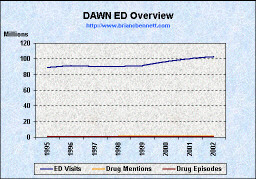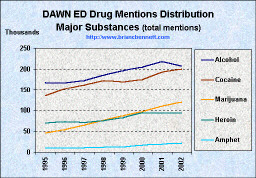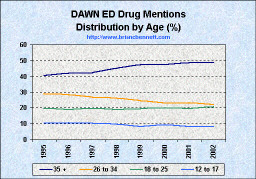| Drugs and the Emergency Department | |
|---|---|

|

|

|

|
|
One of the many things we're told about the "dangers" presented by some drugs and their users is that people have to go to the Emergency Department (ED) due to their use of drugs, and that the number of people this happens to is a major problem and increasing every year.
To get to the bottom of the issue, I obtained the original data from the Drug Abuse Warning Network (DAWN) which shows in extraordinarily deep detail, exactly what is going on with "drug abuse episodes" as they are called. Two of the frequently cited parameters pertaining to the issue of drugs and the ED are "drug episodes" and "drug mentions." These definitions are verbatim from the DAWN ED reports:
"The number of emergency department mentions involving marijuana increased 15% from 96,426 mentions in 2000 to 110,512 in 2001. The rate of marijuana mentions for patients age 12 to 17 increased 23% between 1999 and 2001 (from 55 to 68 per 100,000 population) and 126% (from 30 to 68 per 100,000 population) since 1994." Source: ONDCP FactSheet on Marijuana, Jan 27, 2003. Comment: This certainly sounds terrible. But what does it really mean?
"The roughly 470 hospital emergency rooms participating in the Drug Abuse Warning Network give a sense of the scope of the problem -- roughly 175,000 emergency room incidents related to cocaine each year, while heroin and marijuana are each implicated in roughly 97,000 incidents." Source: ONDCP, 2002 National Drug Control Strategy Comment: This sure does sound serious. Are we supposed to be alarmed by this information? Is this a problem of such magnitude that it necessitates hunting down and jailing our fellow citizens to "protect" them from doing this to themselves? We need to put these numbers and these issues in perspective. We need to know what the magnitude of this data is and why it is or is not sufficient to justify our drugwar. Based on the idea that the number of emergency room visits due to drug use is cause for a huge war being waged on the users of said drugs, one can only wait with bated breath for the War on Sports to begin. Afterall, among young people basketball injuries alone send more than 13 times as many people to the ED as does marijuana.
|
| Drugs and the Emergency Department | |
|---|---|

|

|

|

|
|
The number of ED visits reached 100 million per year in 2001, and drug episodes accounted for about six-tenths of one-percent (638,000) of all ED visits that year.
The major substances of abuse account for 57 percent of drug mentions, while the remaining 43 percent of drug mentions are accounted for by "other substances of abuse." Antidepressants, analgesics and benzodiazepines account for the large majority of drug mentions involving these other substances of abuse. Alcohol in combination with at least one other drug accounts for 33 percent of all drug episode ED visits. The true number of incidents involving alcohol is not tabulated, as alcohol is only counted when used in combination with other drugs. Cocaine is mentioned in 30 percent of all drug episodes, while heroin is mentioned in 15 percent of drug episodes and marijuana is mentioned in 17 percent.
While heavily maligned, marijuana is mentioned in only slightly more than one-tenth of one-percent of all ED episodes. Additionally, when marijuana is mentioned alone, it accounts for less than two one-hundreths of a percent of all Emergency Department episodes. Curiously, some 8 percent of the population aged 12 and older have used marijuana in any given year. When 20 million people do something and at most 110,000 (or about one-half of one-percent) of them end up in the emergency room, do we really have a problem? Of all marijuana ED mentions, more than 85 percent involve those over age 18. Our "children" simply aren't going to the emergency room due to marijuana use. The truth is that hardly anyone is. For the sake of putting this all in perspective, consider that the population of the U.S. is about 285 million people and there are 100 million ED episodes per year. That works out to one ED episode for every two people. There were 670,307 drug epsiodes in 2002 -- which works out to one episode for every 425 people. What in the hell are we thinking? |
| truth: the Anti-drugwar | Anti-drugwar Arsenal | Accept the $1 Challenge |